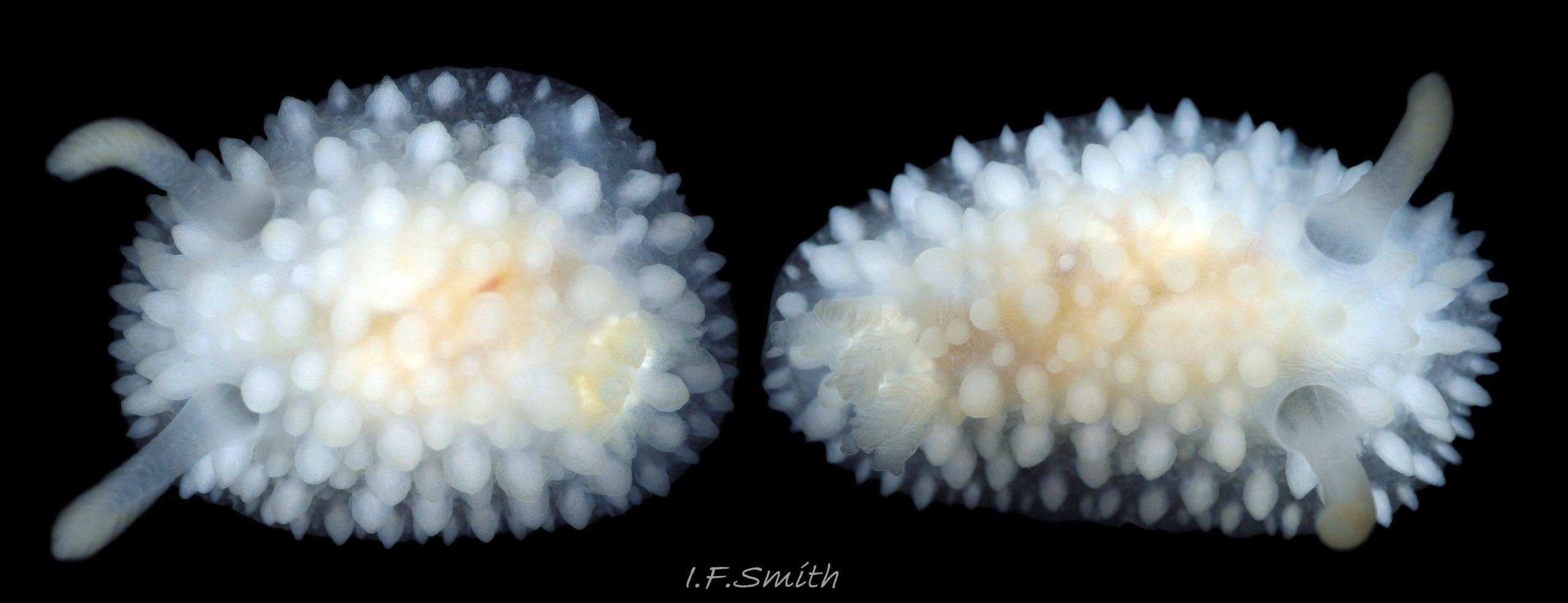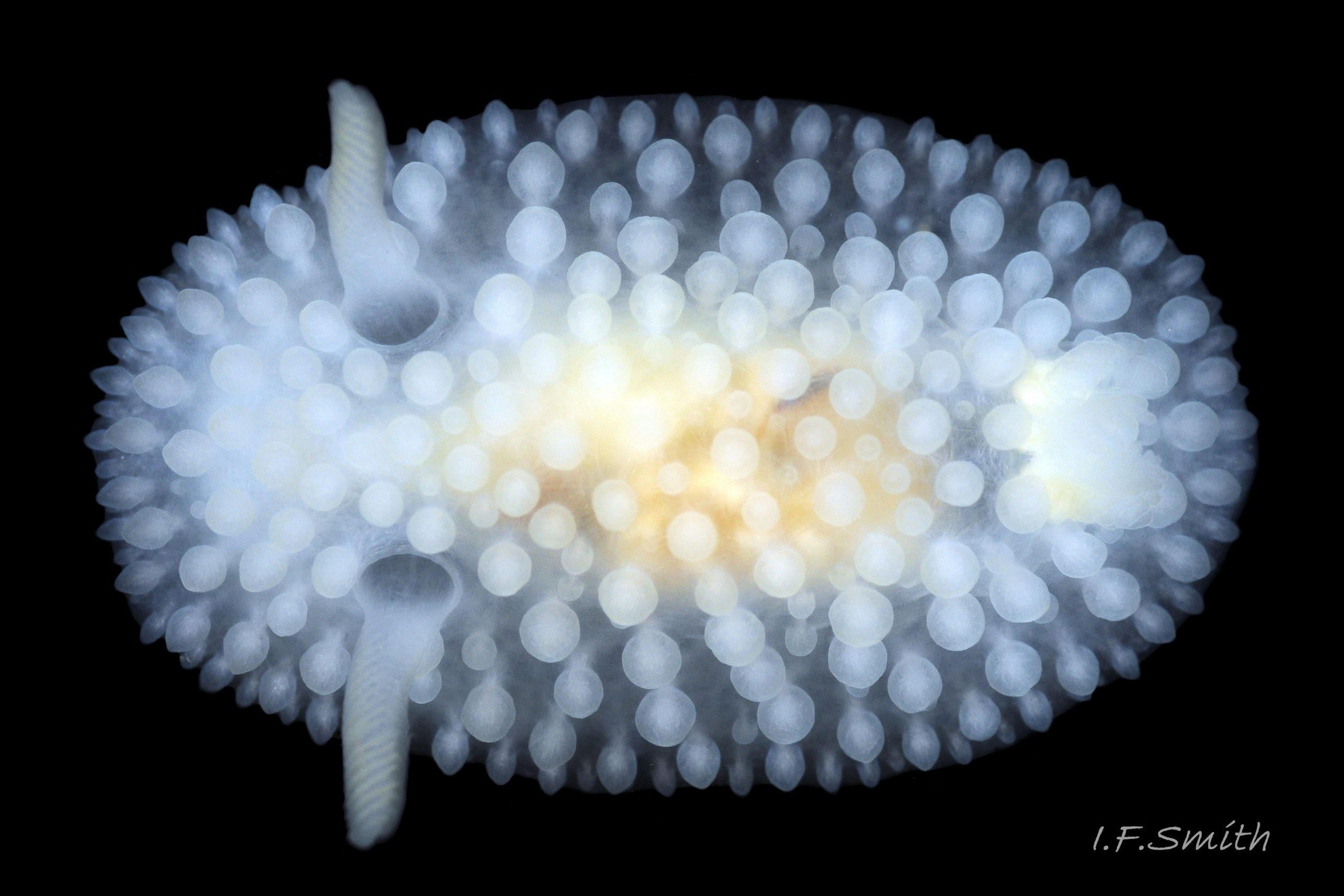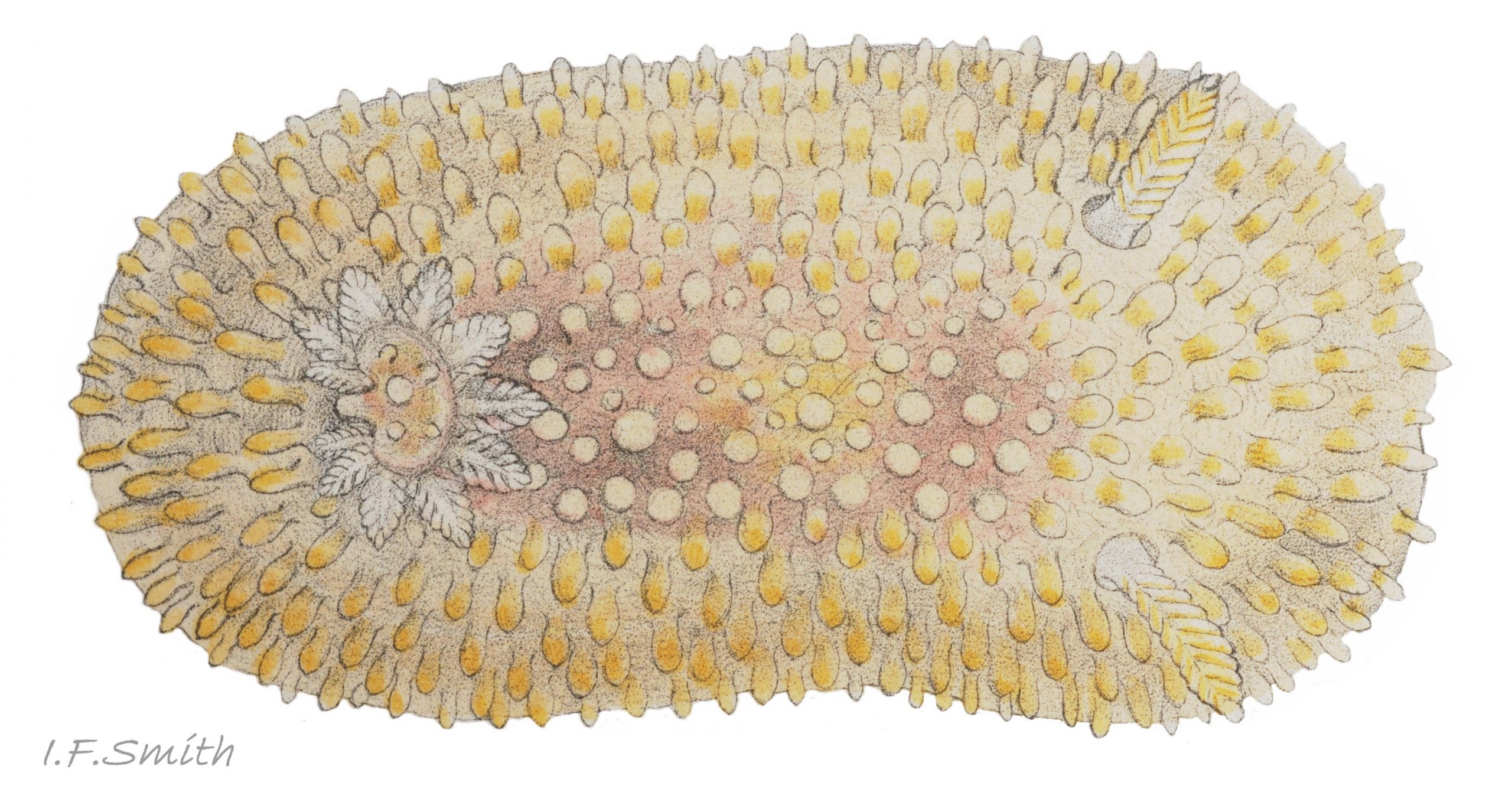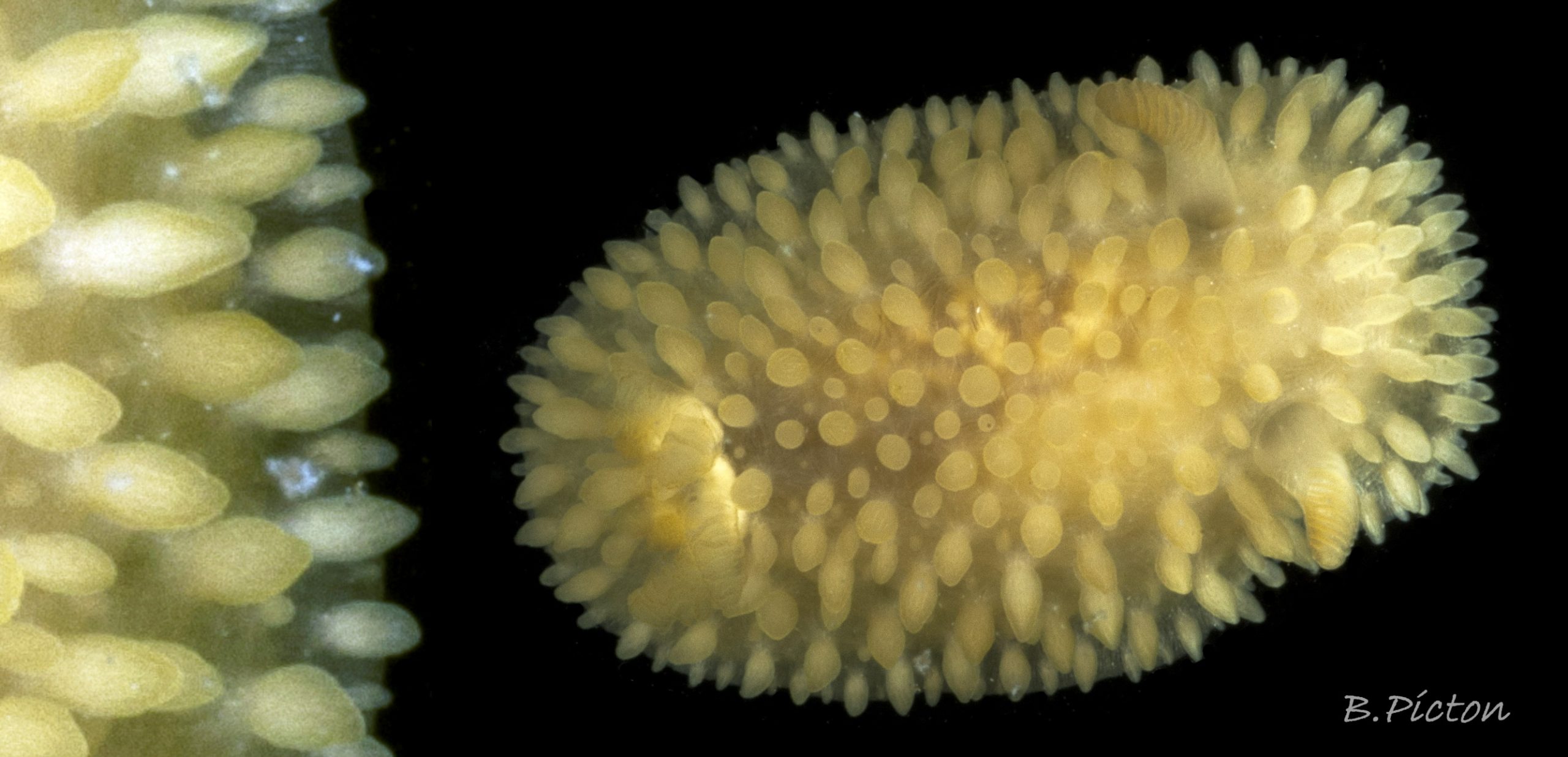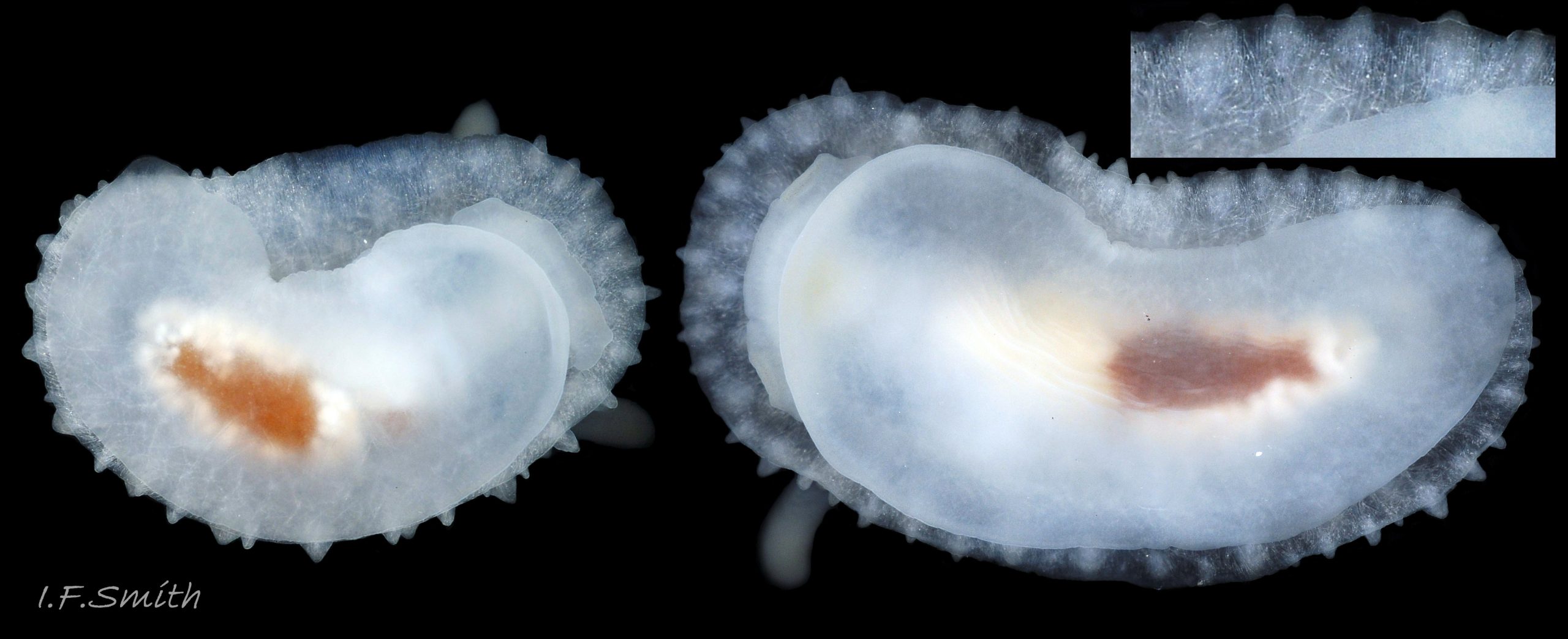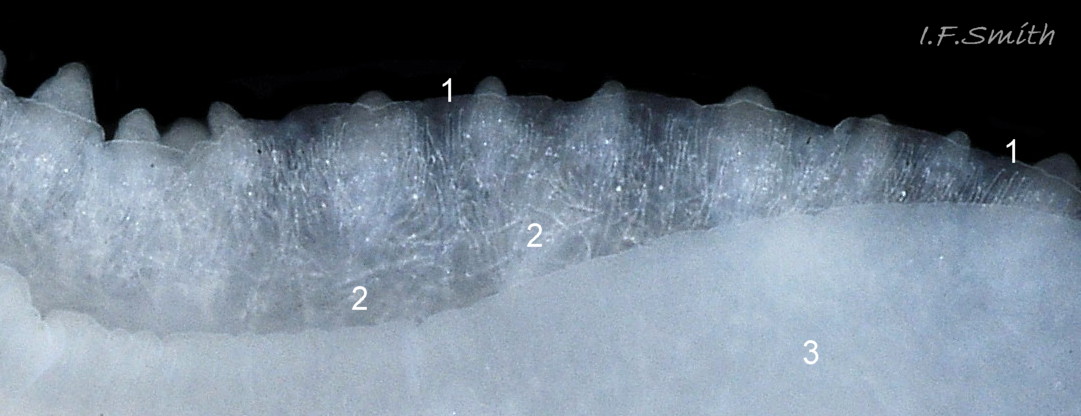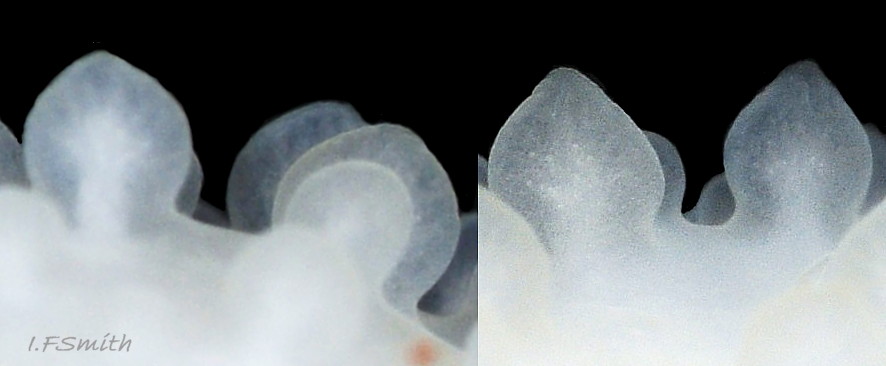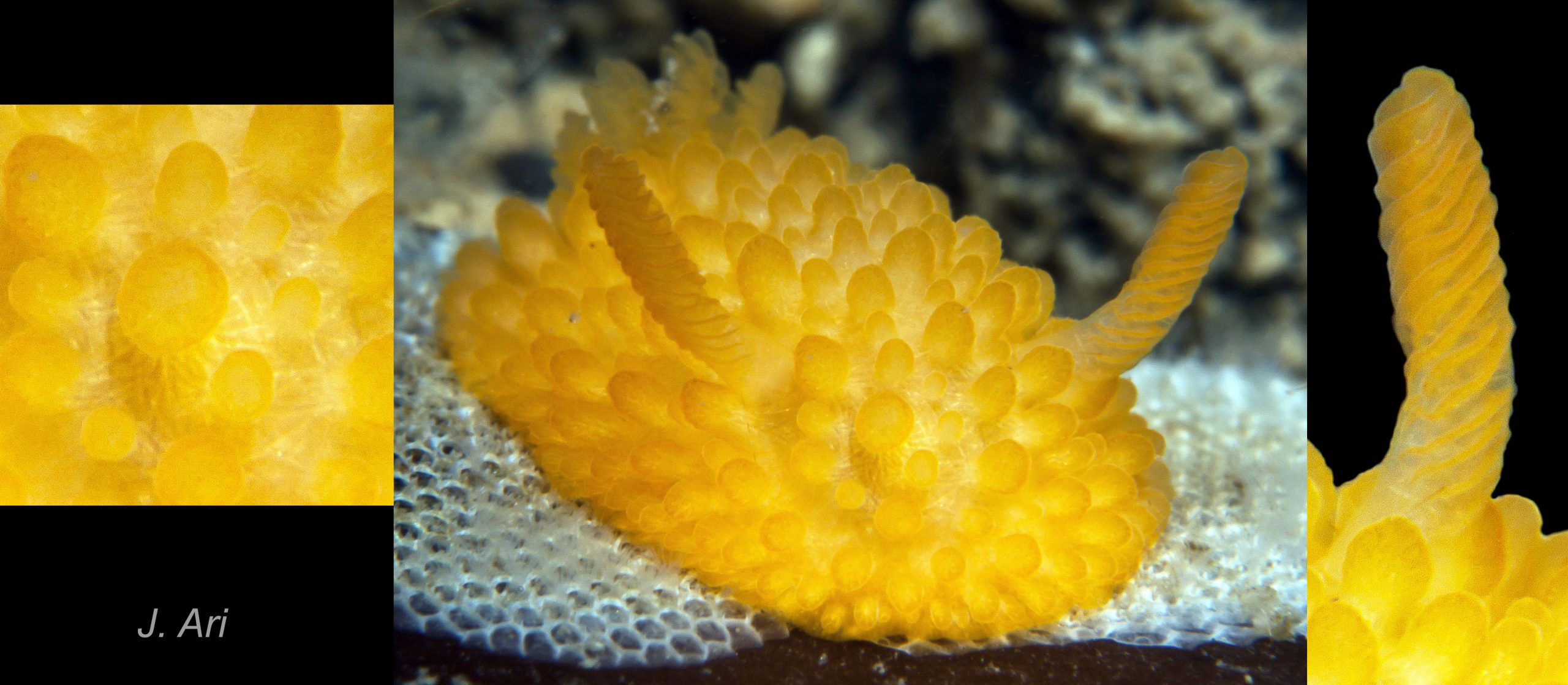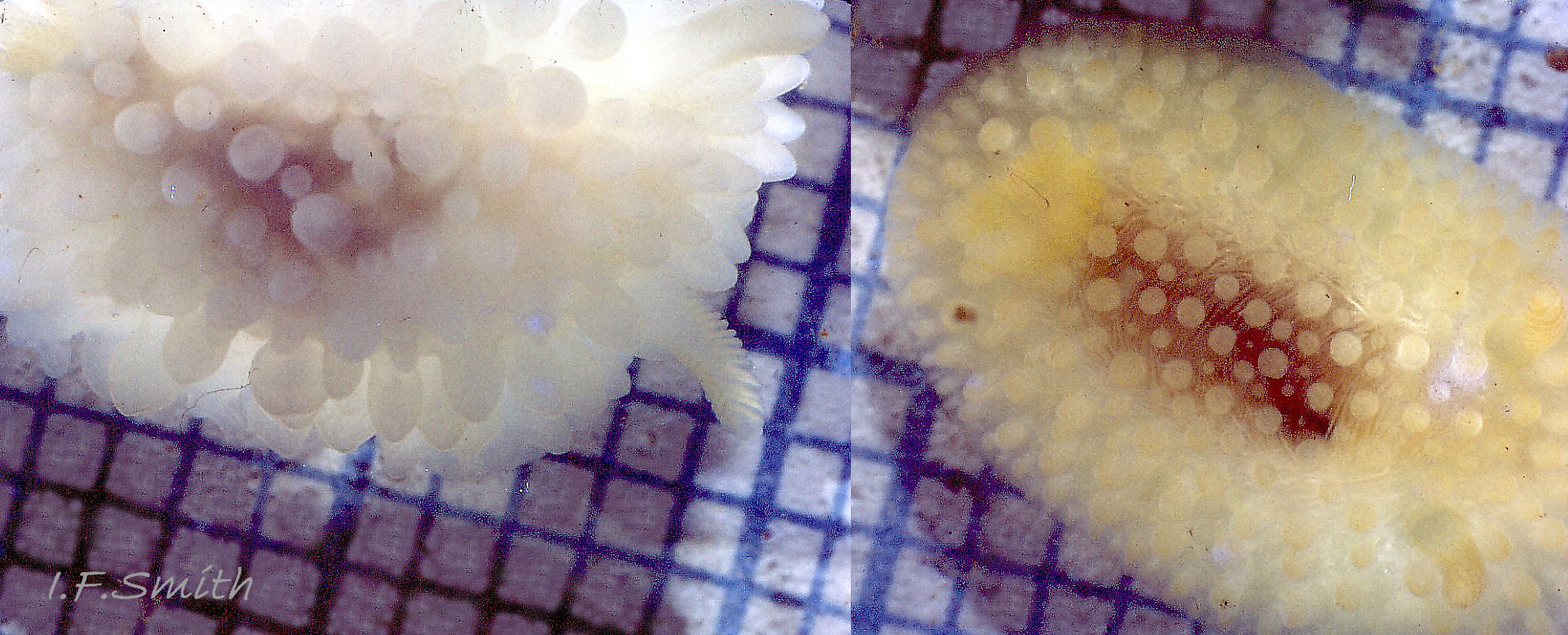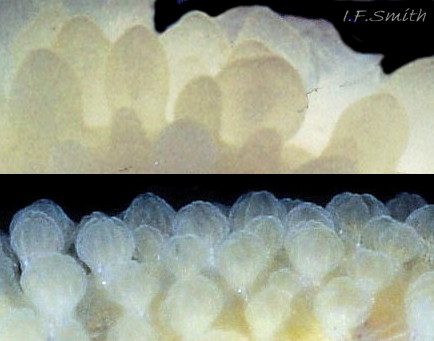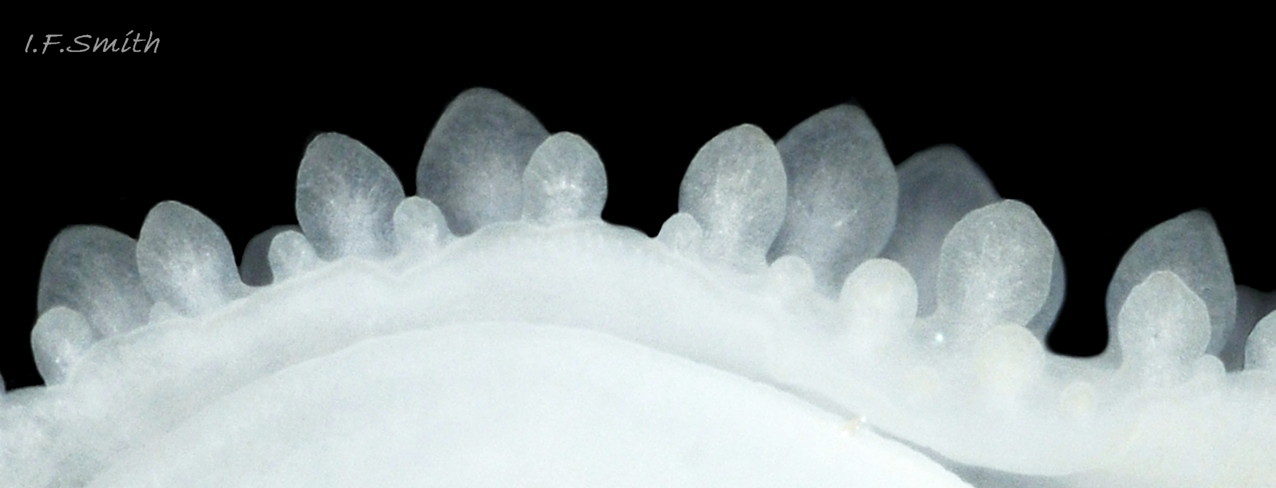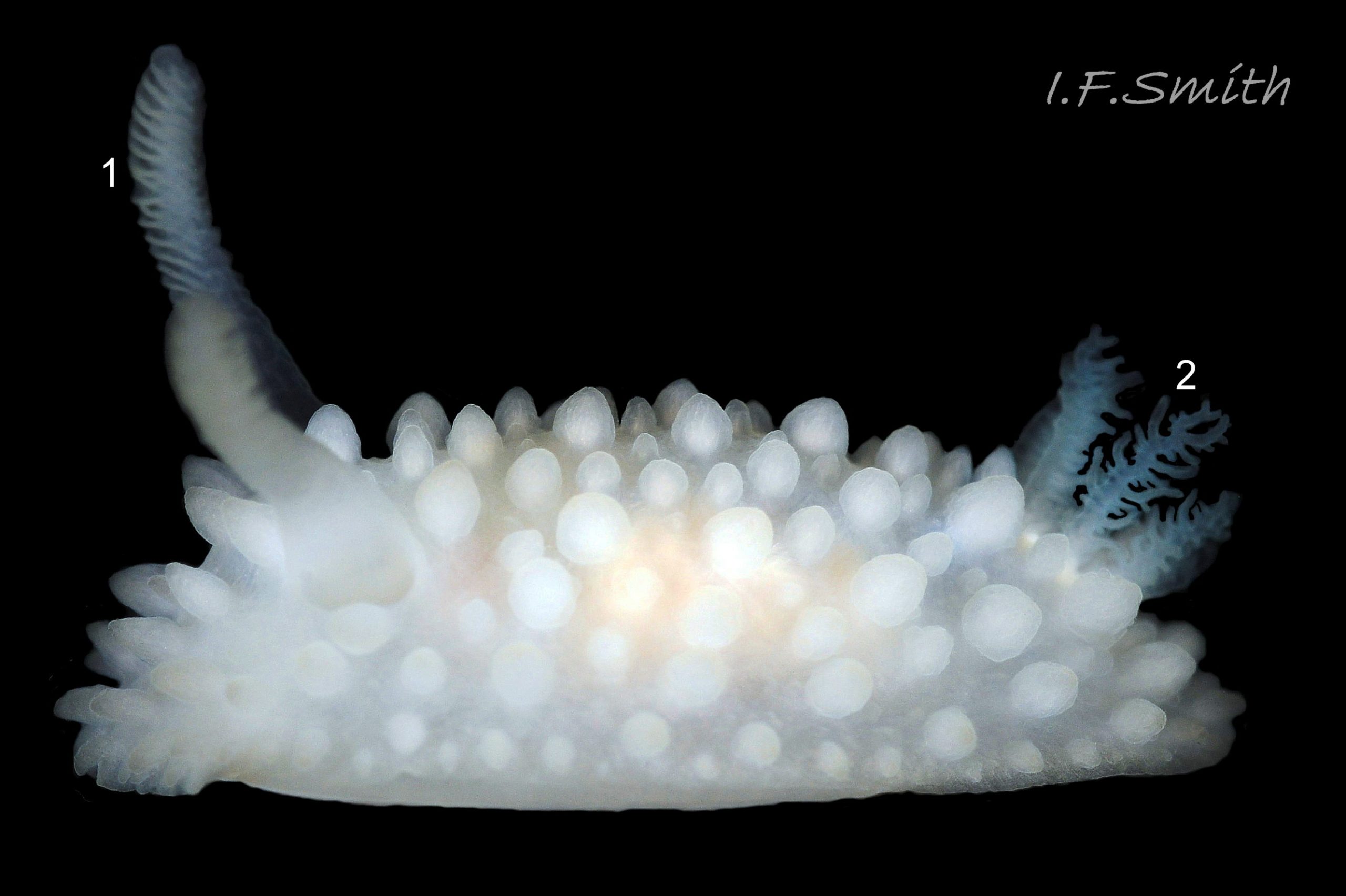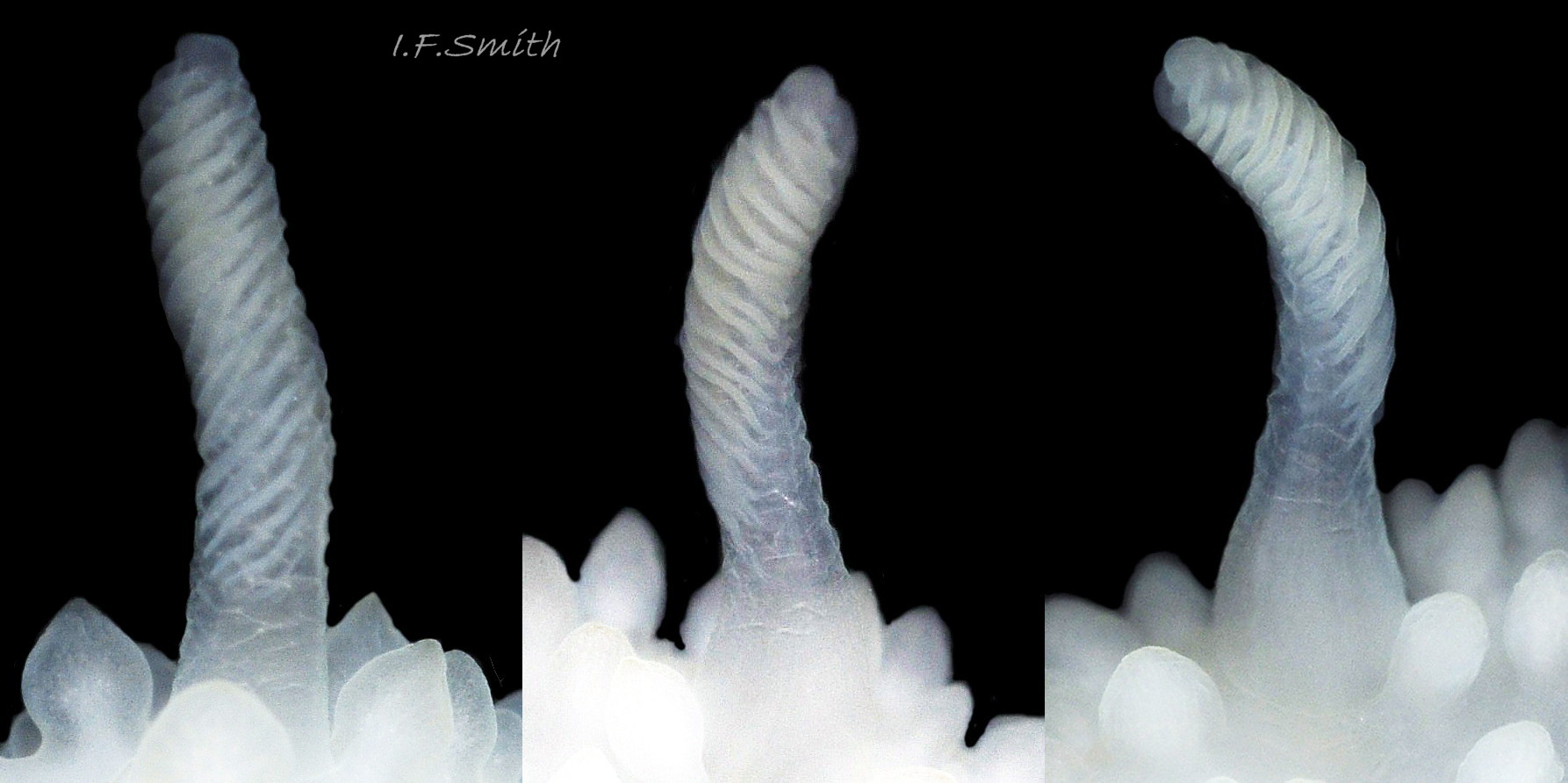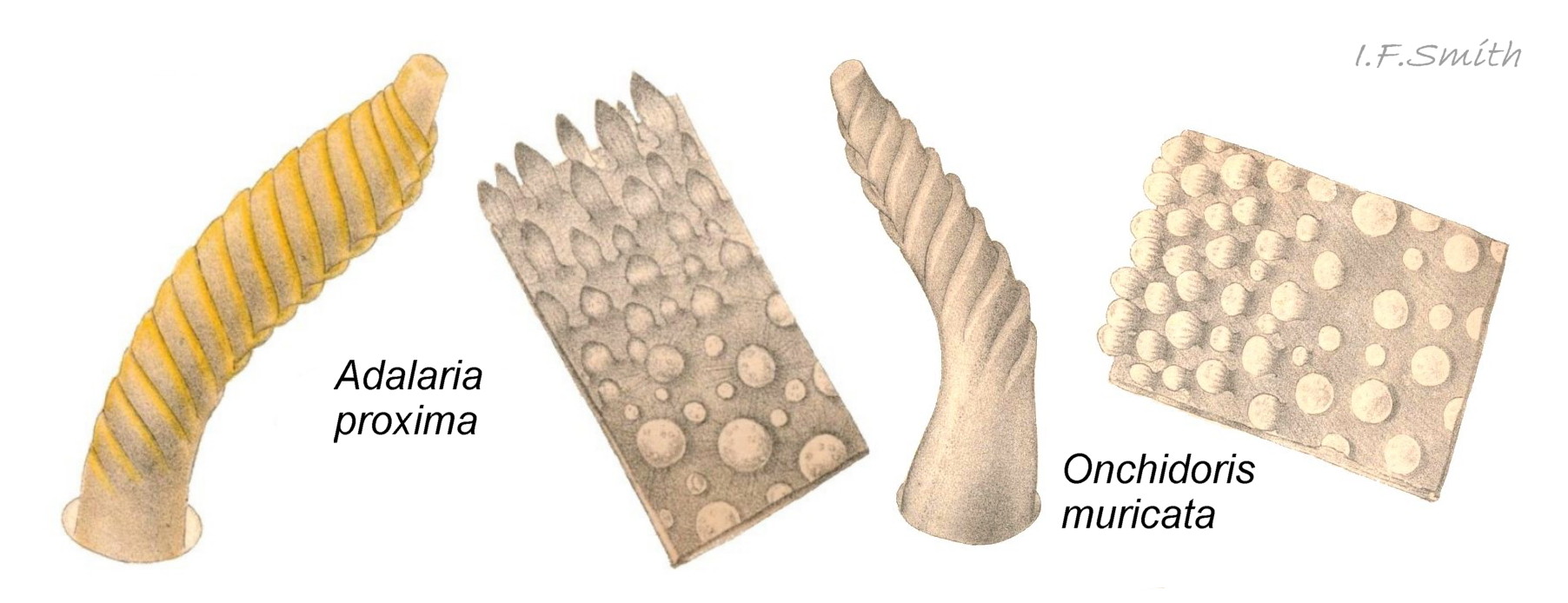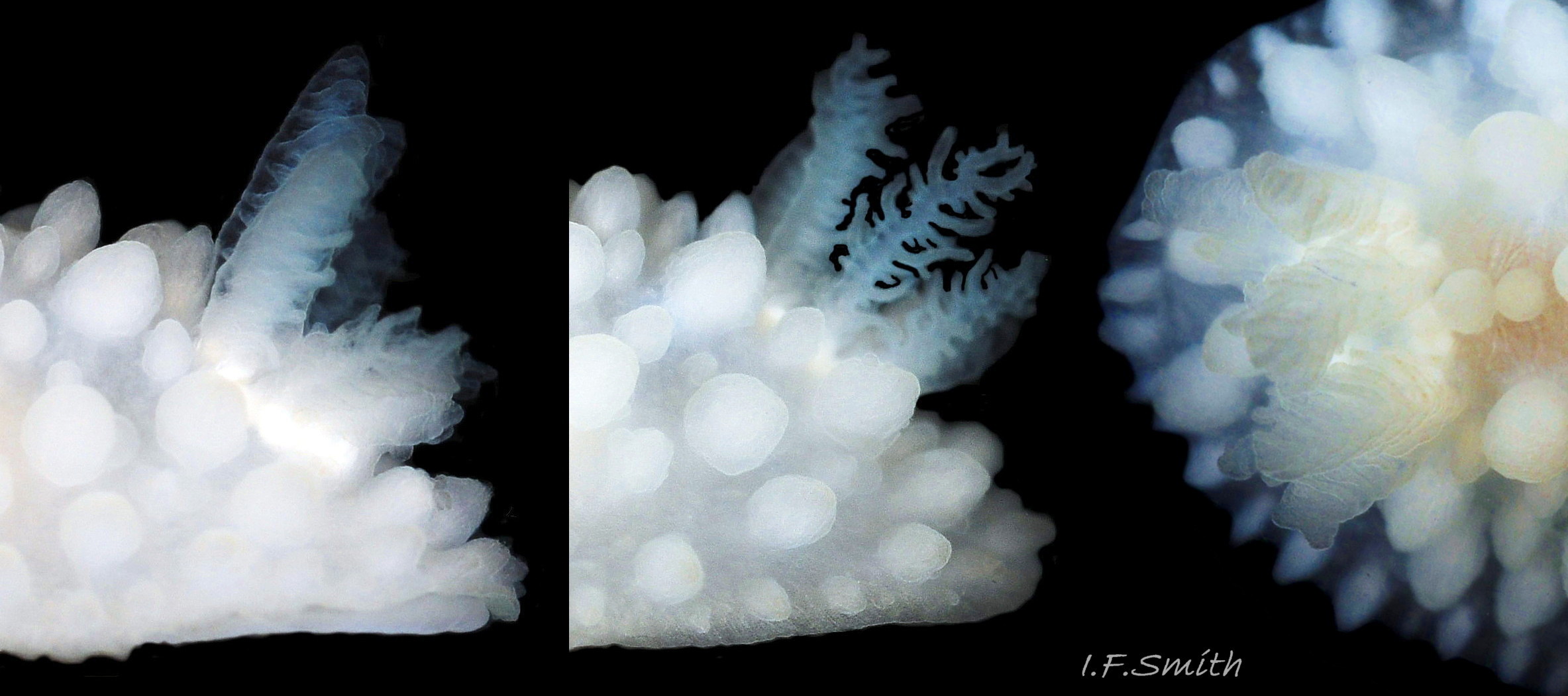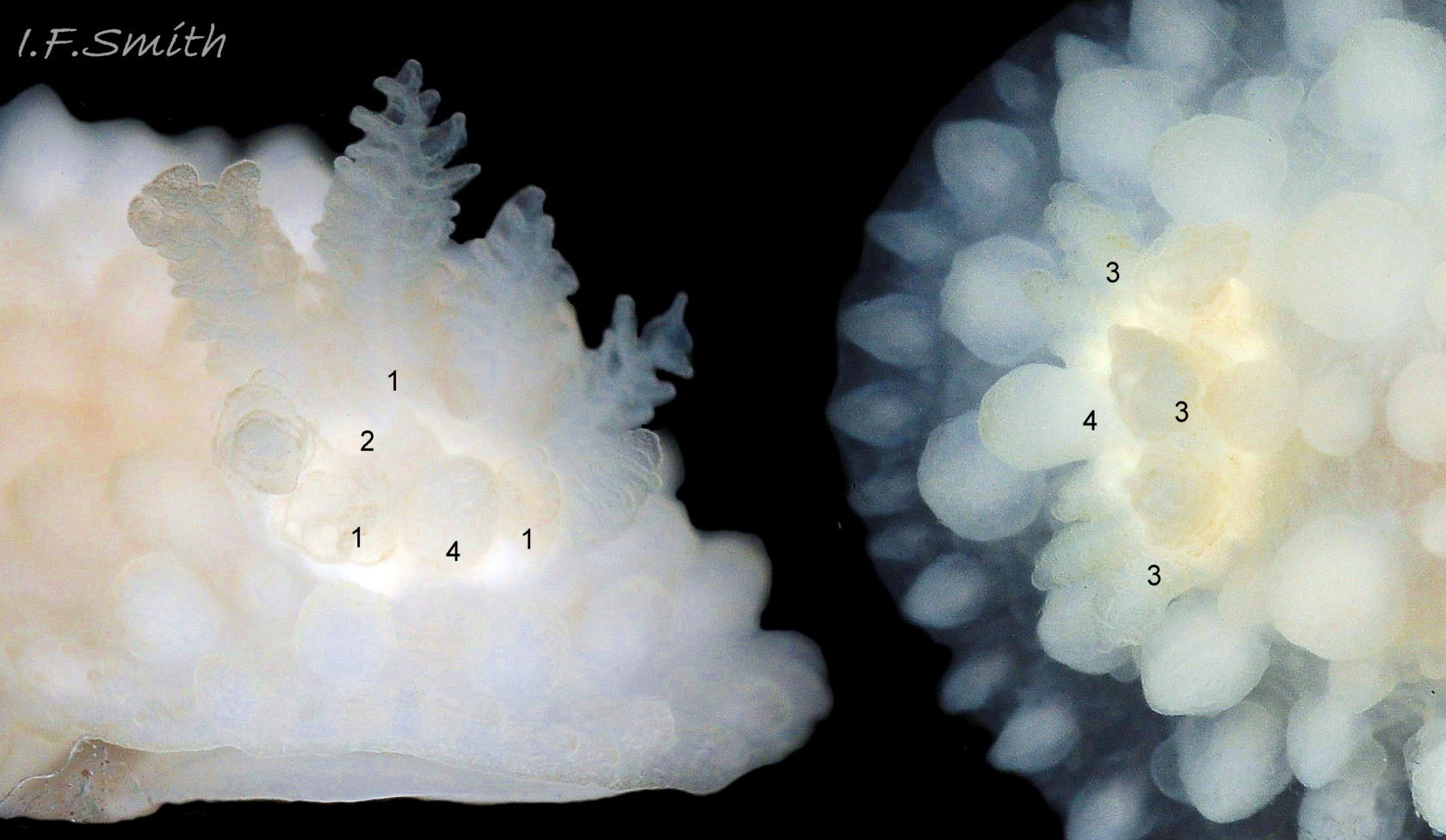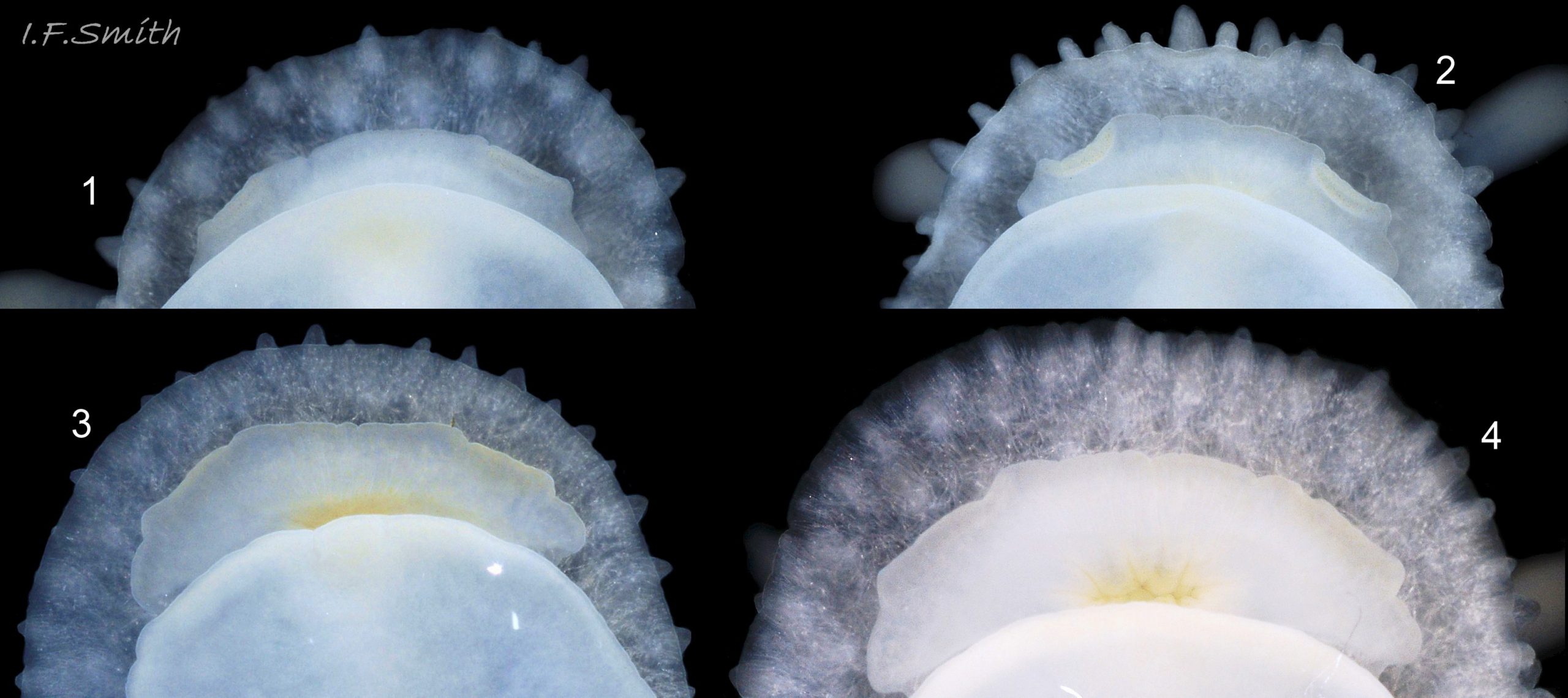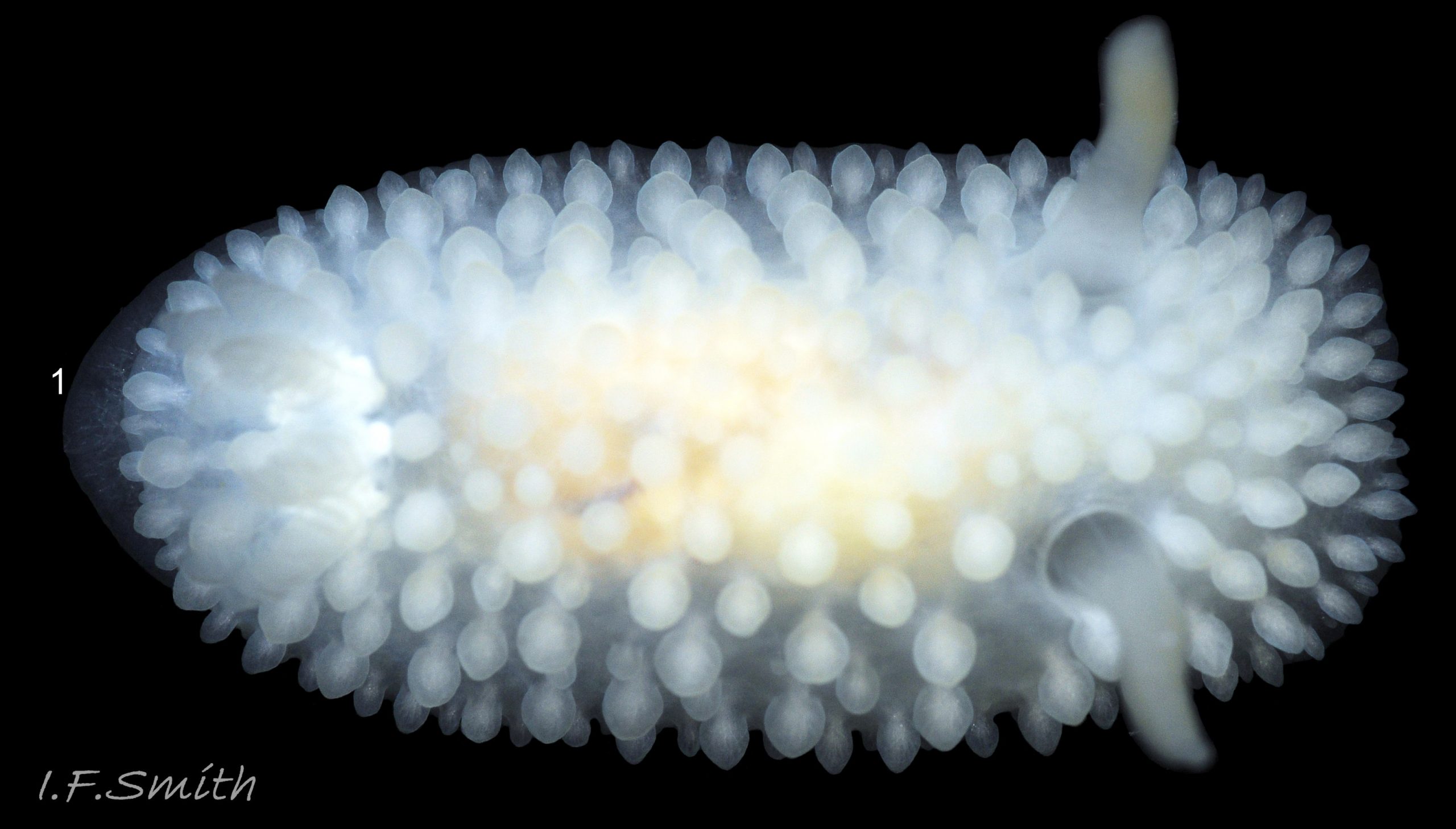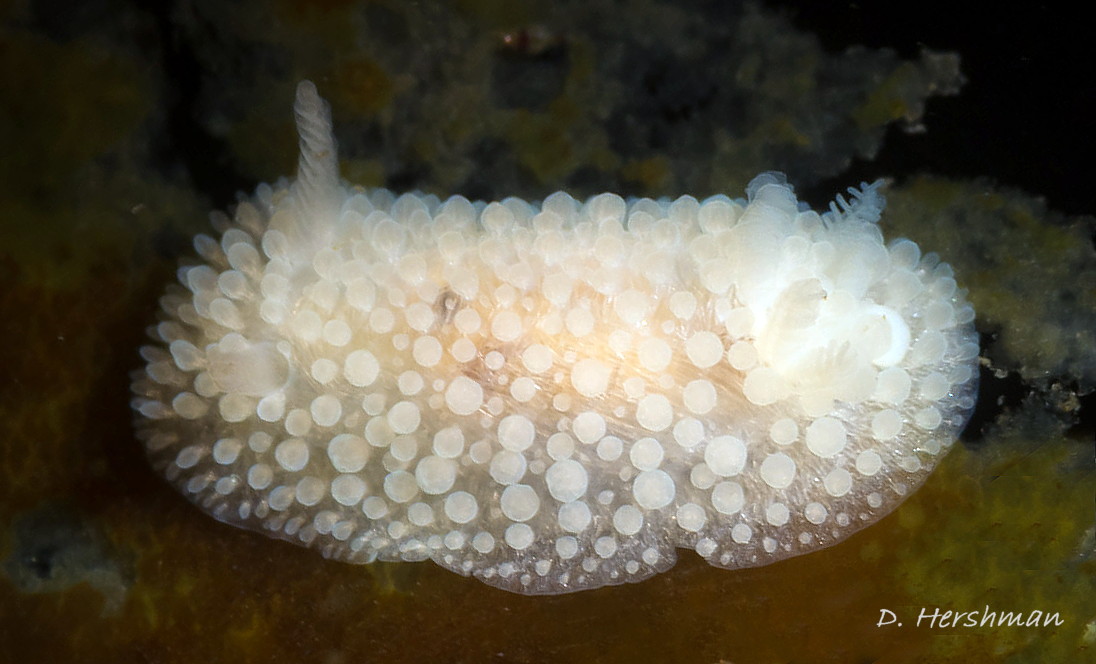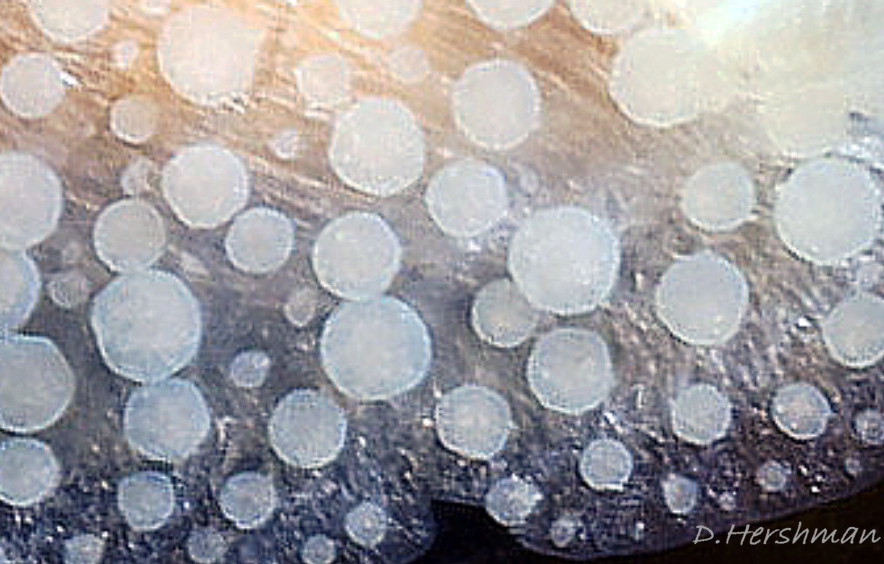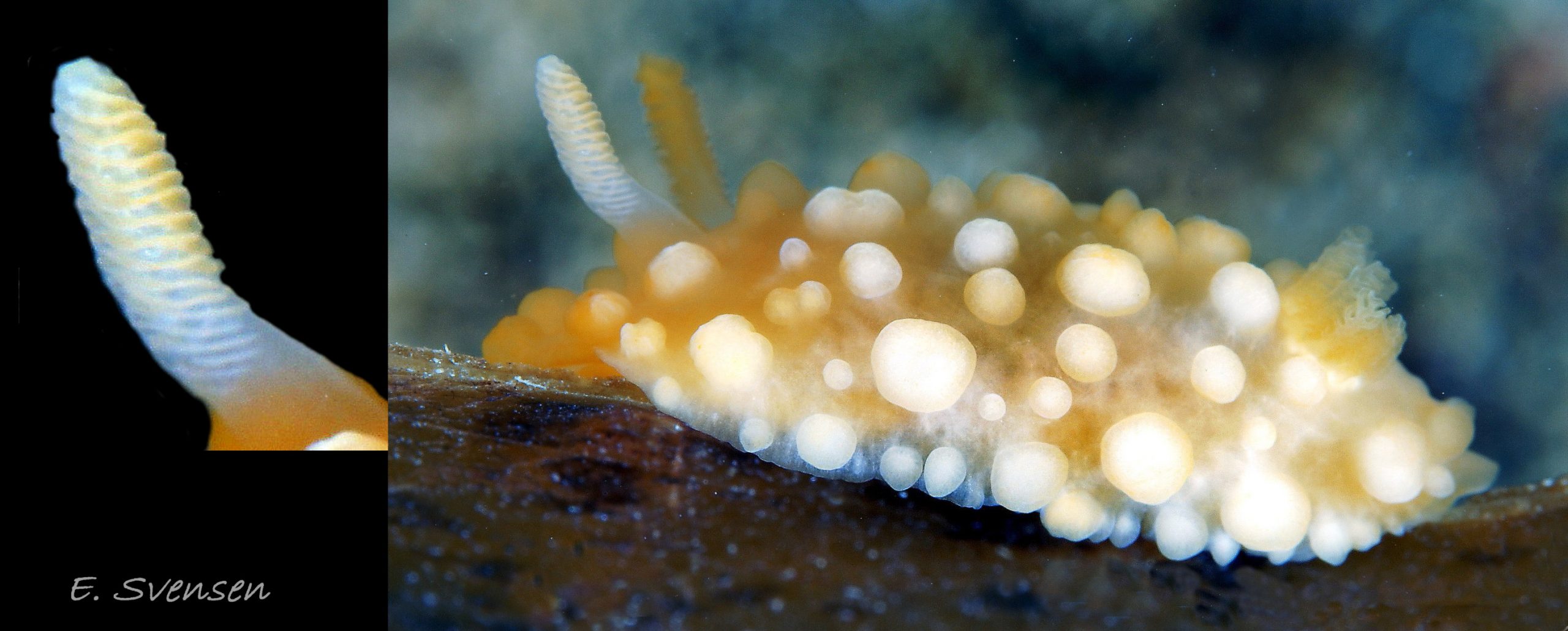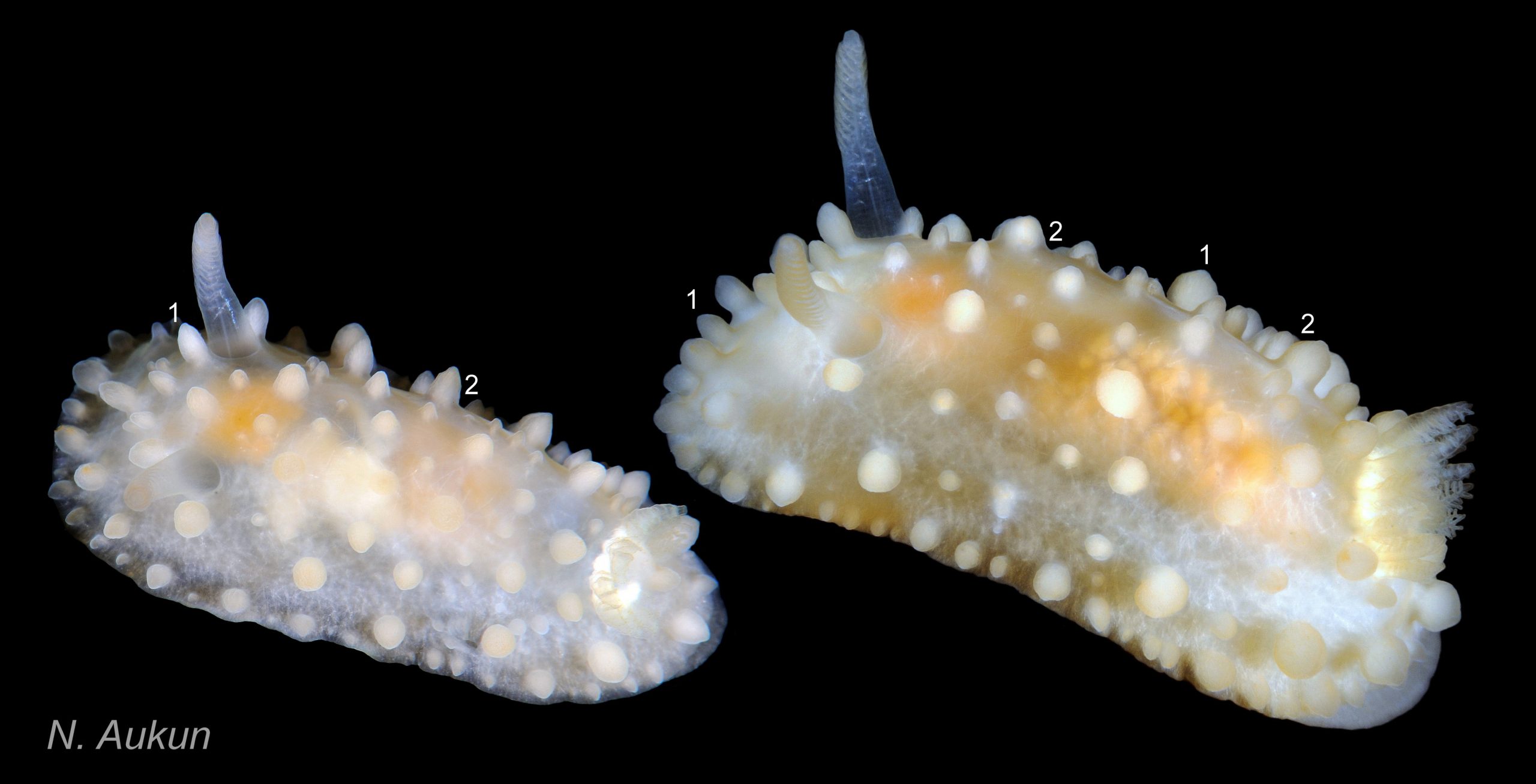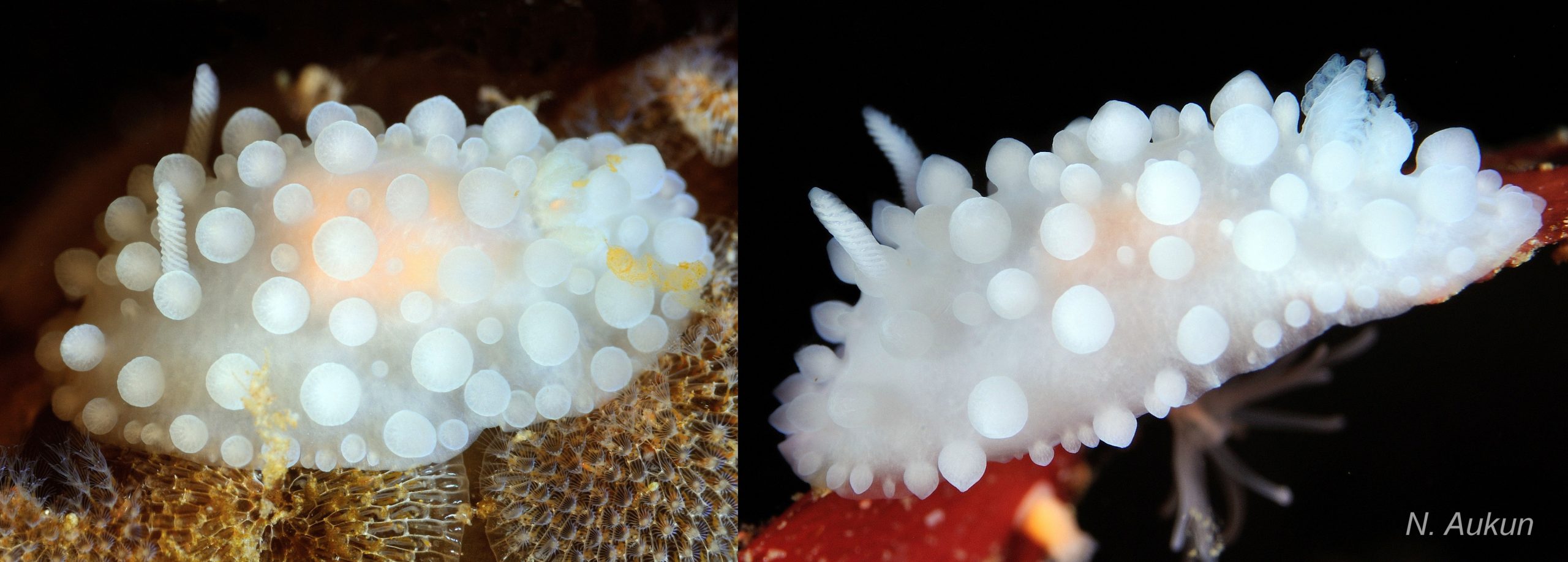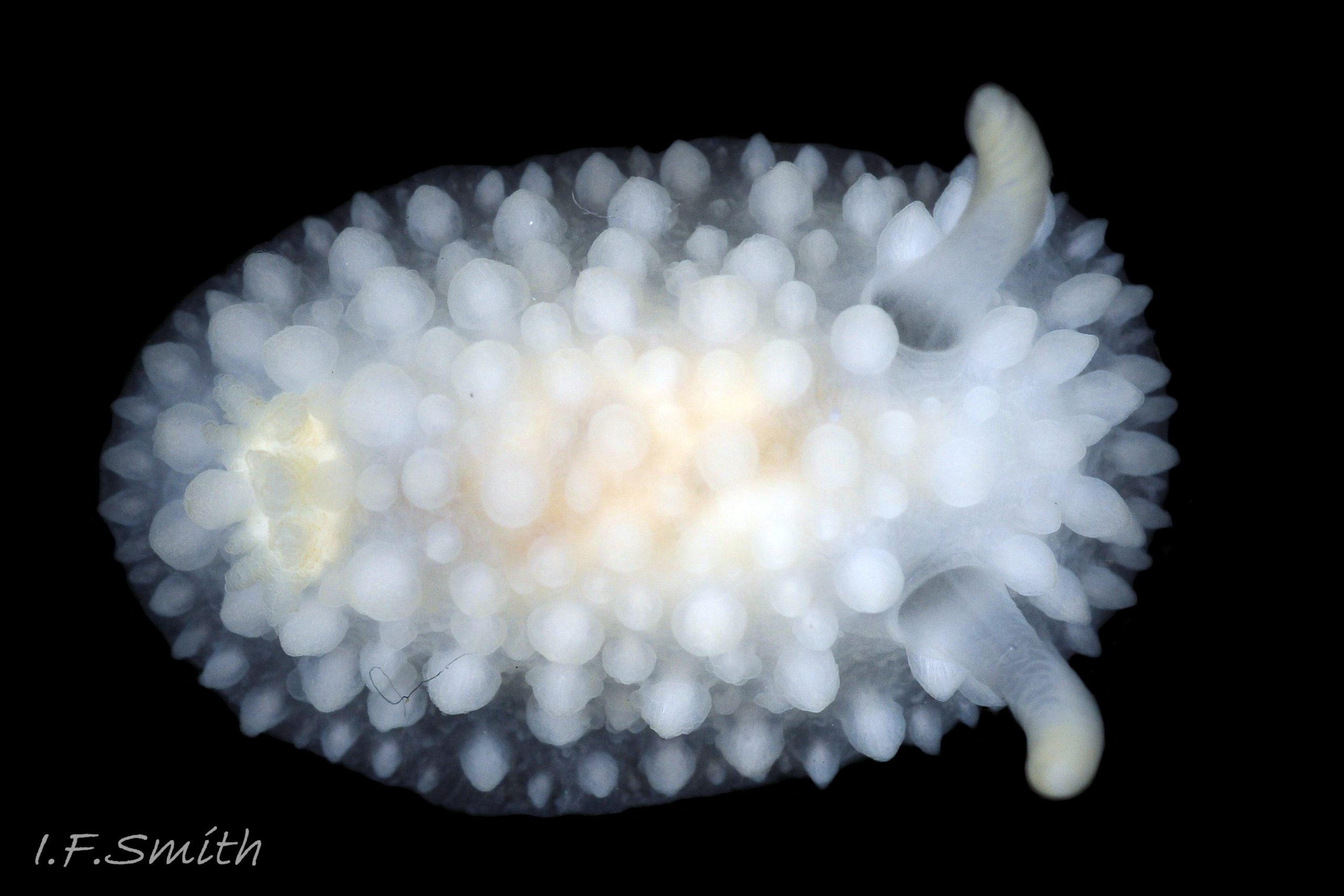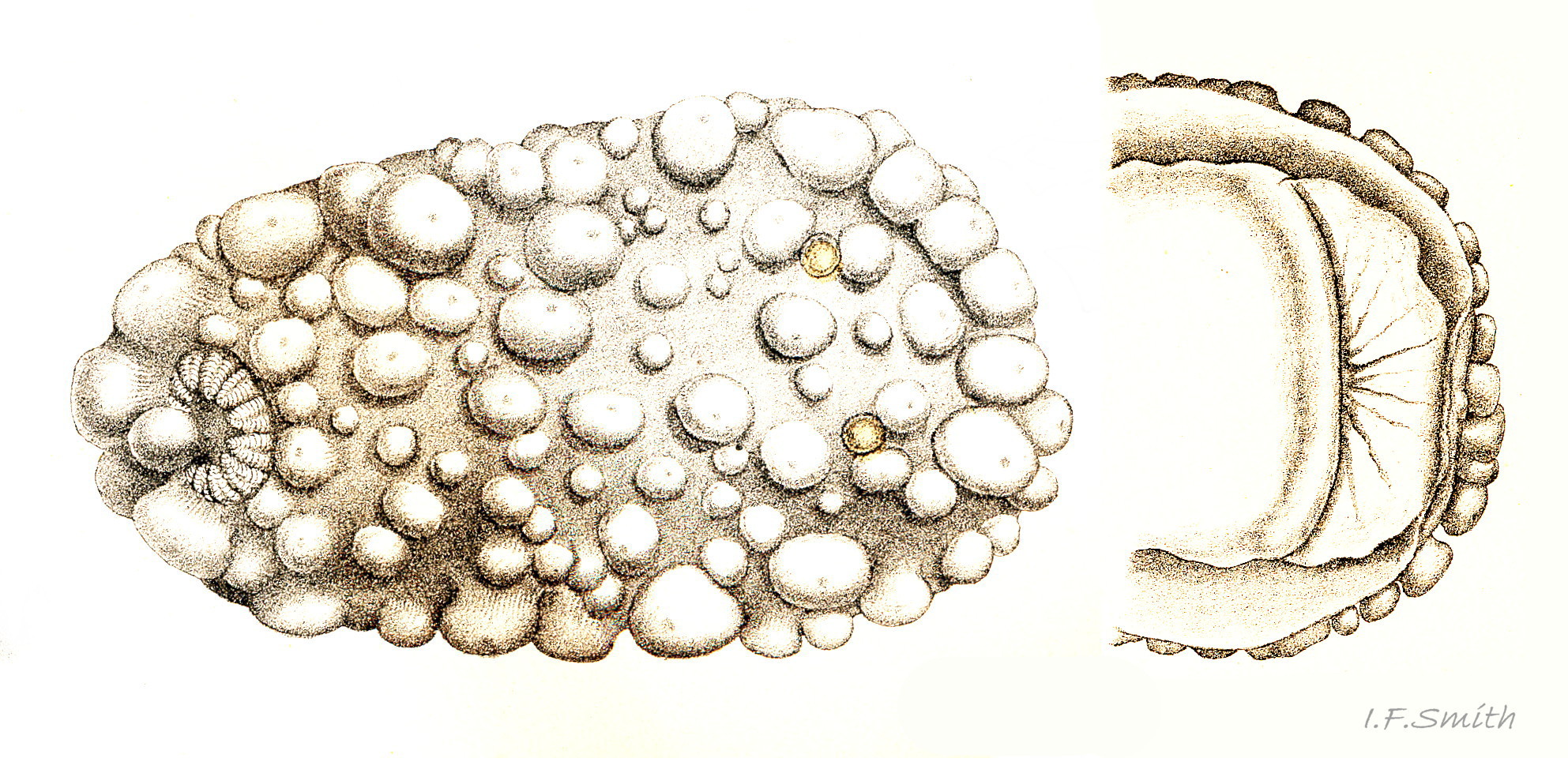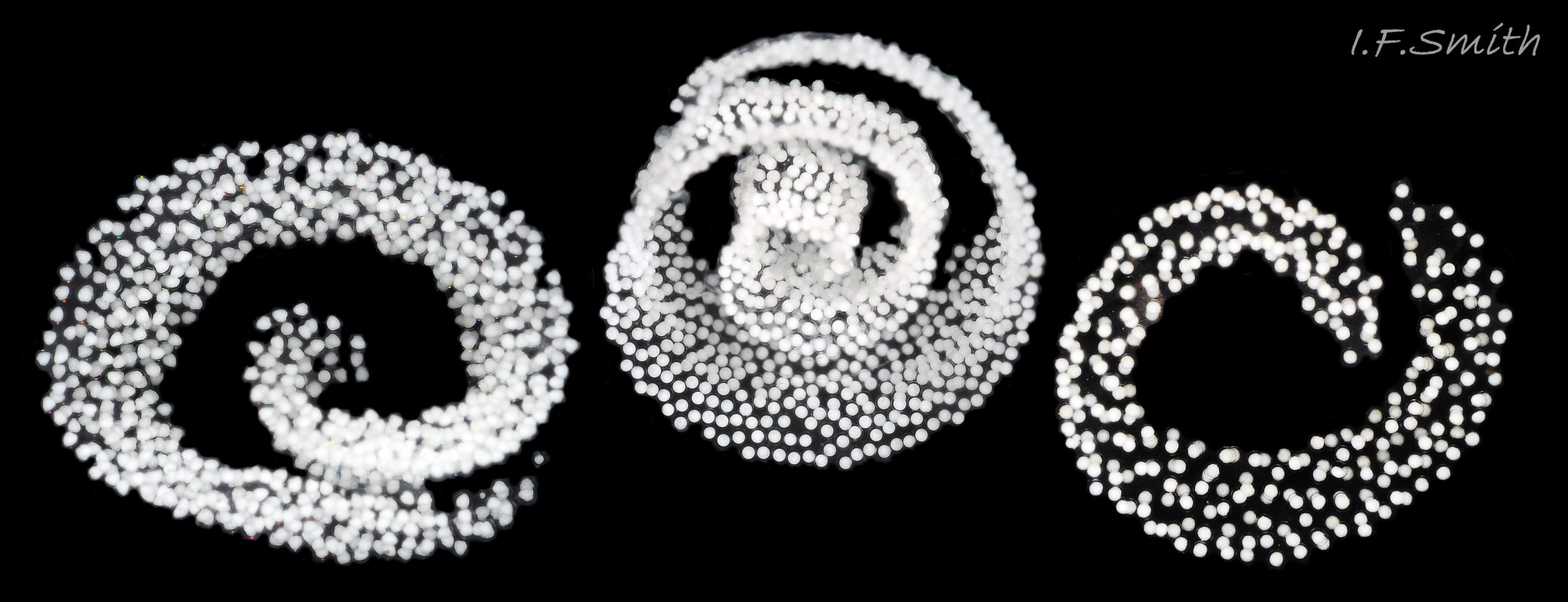Click image to enlarge with full caption. Main text below slider.
Adalaria proxima (Alder & Hancock, 1854)
PDF available at https://www.researchgate.net/publication/380099040_Adalaria_proxima_Alder_Hancock_1854_Identification_and_Biology
Synonyms: Doris proxima Alder & Hancock, 1854; Onchidoris proxima (Alder & Hancock, 1854).
Current taxonomy: World Register of Marine Species (WoRMS)
http://www.marinespecies.org/aphia.php?p=taxdetails&id=140629
GLOSSARY below.
Body description
The body of A. proxima is a flattened ovoid varying in outline with contraction and extension 01 Adalaria proxima . It grows up to 17 mm long in Britain and Ireland, and 25 mm is reported further north. The ample mantle covers the whole body. It varies between white 02 Adalaria proxima , mainly in northern Britain, or yellowish 03 Adalaria proxima & 04 Adalaria proxima , mainly further south, but the species is absent from south of the Bristol Channel. The mantle has many calcareous spicules; some radiate from the bases of tubercles 05 Adalaria proxima . Spicules are often not easily seen dorsally; a ventral view may give better sight of them 06 Adalaria proxima . Near the mantle edge, many spicules are aligned pointing out from the body, but away from the edge they are crossed by others giving a more confused appearance 07 Adalaria proxima . The mantle is covered by elliptical or fusiform tubercles with a rounded apical point and a narrowed base; the greatest circumference is usually about 45% of the height from the base 08 Adalaria proxima .
Tubercle inflation varies greatly; some apparent geographical variations include:
V1: Dull yellowish/orange with slightly swollen, elliptical or fusiform tubercles found mainly in Northern Ireland, Wales and England 04 Adalaria proxima & 03 Adalaria proxima .
V2: Bright golden-yellow or orange with moderately swollen tubercles found in the Lille Belt, Denmark and possibly more widely on the Baltic coast of Denmark 09 Adalaria proxima & 10 Adalaria proxima .
V3: Pure, translucent white with moderately swollen tubercles in Orkney, Scotland 11 Adalaria proxima & 12 Adalaria proxima .
V4: Pure, translucent white with inflated onion-shape tubercles. Outer Hebrides, Scotland and possibly most of western Scotland 02 Adalaria proxima & 08 Adalaria proxima .
Newly formed tubercles near the edge of the mantle 13 Adalaria proxima , or tubercles on small juveniles, are often smaller and thinner. A bundle of calcareous spicules is sometimes faintly visible as a more opaque vertical core which fans out at the top in each tubercle 13 Adalaria proxima . From above, yellow ovotestes may be visible through the translucent mantle of mature specimens 02 Adalaria proxima .
The linear, untapered, often curved backwards rhinophores 14 Adalaria proxima have about 10 lamellae when the slug is 5 mm long, about 15 when 10 mm 15 Adalaria proxima , and about 18 when 15 mm (Thompson & Brown, 1984). The lamellae slope up towards the anterior; the lower ones do not meet on the posterior face of a rhinophore. A small blunt apex protrudes above the lamellae 16 Adalaria proxima . The basal part is smooth and swollen. There is no obvious rhinophoral sheath, but the rim of the retraction pit is slightly raised 05 Adalaria proxima . The rhinophores are usually slightly darker than the mantle; on pure white specimens they are usually a duller yellowish-white 02 Adalaria proxima .
The gills are unipinnate with a thick midrib and crooked, variably-sized pinnae 14 Adalaria proxima & 17 Adalaria proxima . There are about 6 gills when the slug is 5 mm long, about 9 when 10 mm and about 11 when 15 mm (Thompson & Brown, 1984), arranged around the anus in a ring with a posterior gap occupied by a tubercle 18 Adalaria proxima . On white specimens the gills and mantle are translucent white with an opaque white area at the base of the gills. A proxima, like other species in the family Onchidorididae, is a phanerobranch with gills which contract independently of each other and do not retract out of sight into a single common cavity 18 Adalaria proxima .
When fully extended, the head has a large, semicircular oral veil in front of a large oral opening with wrinkled edges 19 Adalaria proxima . A section of the front edge of the veil is often folded down on right and left. On white specimens the veil is translucent white with pale yellow around the opening. The foot is rounded at both ends; more broadly and gently at the anterior 06 Adalaria proxima . It is concealed by the ample mantle and rarely extends beyond the rear of the mantle edge 20 Adalaria proxima . On white specimens the sole is translucent white showing through its posterior half the slightly-purplish brown digestive gland 06 Adalaria proxima .
Key identification features
Adalaria proxima
1) Up to 17 mm long in Britain and Ireland, 25 mm reported further north.
2) Ovoid, club-shape tubercles with a rounded apical point and a narrowed basal stem; the greatest circumference is usually about 45% of the height from the base08 Adalaria proxima .
3) Core of spicules in tubercles 13 Adalaria proxima . Mantle spicules radiate from tubercles; not in visible diagonal lines.
4) On large specimens 15 mm long, up to nineteen lamellae on each linear, untapered rhinophore arising from a smooth, swollen, sheathless base 15 Adalaria proxima & 16 Adalaria proxima . Erect rhinophore often curved backwards 14 Adalaria proxima .
5) Absent further south than Bristol Channel.
Similar species
Onchidoris muricata (O. F. Müller, 1776). 21 Adalaria proxima
1) Usual maximum length 14 mm.
2) Spheroidal, club-shape tubercles with gently rounded or flattened apex and narrowed base; greatest circumference usually about 66% or more of the height from the base 16 Adalaria proxima & 11 Adalaria proxima . Body quite firm with many spicules.
3) Tubercles have spicules creating appearance of segments of a peeled orange 12 Adalaria proxima .
4) Up to 12 lamellae on each rhinophore 16 Adalaria proxima .
5) On rocky shores all round Britain, including south coast.
Adalaria cf. proxima 22 Adalaria proxima & 23 Adalaria proxima
2) Ovoid club-shaped tubercles with a rounded apical point and a narrowed basal stem; the greatest circumference is usually about 45% of the height from the base.
3) Tubercles have longitudinal spicules. Dorsolateral mantle spicules in diagonal lines.
4) About ten lamellae on each linear, slightly tapered rhinophore arising from a smooth, sheathless base.
5) On Pacific coasts of Canada and north-west U.S.A.
Adalaria loveni (Alder & Hancock, 1862)
1) Up to 32 mm long.
2) Widely spaced, very large, wider than tall, lumpy, rounded tubercles with flattened tops interspersed with much smaller tubercles 24 Adalaria proxima & 25 Adalaria proxima . Some uncertain specimens have contracted or poorly developed widely spaced tubercles 26 Adalaria proxima & 27 Adalaria proxima .
3) Tubercles are soft with a central core of spicules.
4) On each rhinophore, up to 25 lamellae according to Bergh (1880) in Thompson and Brown (1984), but often fewer 25 Adalaria proxima .
5) On Norwegian coast; possibly absent from Britain and Ireland.
Of A. loveni, Thompson and Brown (1984) wrote, ‘This is a distinctive species’, and Eliot (1910) stated, ‘It can be easily recognised by the huge tubercles’ , but there is uncertainty and lack of consensus on the differentiation of British and Irish specimens from A. proxima. The image of an 8 mm long A. loveni in Thompson and Brown (1984) resembles photographs of A. proxima, such as 28 Adalaria proxima , much more closely than Alder’s image in Eliot (1910) of A. loveni 29 Adalaria proxima and photographs of typical A. loveni 24 Adalaria proxima . The inflation of tubercles on A. proxima varies considerably, and those with the most inflated ones are liable to be mistaken for A. loveni. Norwegian specimens 25 Adalaria proxima show that the tubercles are distinctly shaped and, because none like them have been seen/photographed recently in Britain and Ireland, it has been suggested (Picton & Morrow accessed August 2018) that A. loveni may not occur there now.
Alder and Hancock, who first named the species (1862), wrote, “A single specimen of this species was found by the Rev. A.M. Norman among stones between tide-marks, on the south side of Bantry Bay, in the autumn of 1858. It is remarkable for the enormous size of its tubercles, which, though soft and having a puffed appearance, contain each a bundle of spicula.” It is unknown whether their illustration 29 Adalaria proxima is of the Bantry specimen or a Norwegian one sent to them. It is possible that it was at Bantry in 1858 when the climate was cooler than in the 20th and 21st Centuries. The tubercles on some specimens from Norway are large and widely spaced, as on A. loveni, but in shape resemble, more or less, those on A. proxima 26 Adalaria proxima & 27 Adalaria proxima .
A study (Hallas & Gosliner, 2015), which was not focused on differentiating this pair of species, showed strong similarities in DNA and morphology (J. Hallas, 2018, pers. comm. 31 October) between specimens identified as A. proxima from Maine, U.S.A. and A. loveni from Norway. It is possible that A. loveni is one of the many distinct geographical forms of A. proxima or part of a cline in A. proxima.
Habits and ecology
In Britain, A proxima lives on the lower levels of rocky shores and sublittorally to about 60 m. It feeds preferentially on Electra pilosa which often grows on Fucus serratus and Laminaria as well as other algae and substrates. If E. pilosa is not available, it will feed on other encrusting bryozoans such as Flustrellidra hispida, Membranipora membranacea and Alcyonidium polyoum.
It is a simultaneous hermaphrodite and breeds in Britain from February to May. The spawn is a ribbon attached to algae by one edge in a spiral of one to three turns 30 Adalaria proxima . The ova, up to 2500, are white or cream, and hatch in 5 to 6 weeks at 10ºC into large well developed lecithotrophic larvae which spend a brief time in the plankton, when they may feed but this is not essential for complete metamorphosis into adult form in as little as 24 hours from hatching (Thompson & Brown, 1984). Senescence and death follow shortly after spawning so specimens are rarely seen in summer months while they are ova, larvae or small unobtrusive juveniles. The short time spent in the plankton restricts dispersal and genetic interchange and may favour the development of local variants. This may partly explain differences in colour forms and inflation of tubercles as shown in images 02 Adalaria proxima , 03 Adalaria proxima and 11 Adalaria proxima .
Distribution and status
A proxima has been recorded from Greenland to Massachusetts and from Iceland and Norway to Wales, south-east Scotland and Demark. GBIF map https://www.gbif.org/species/2292099 has records (preserved material) from Alaska to British Columbia, but DNA confirmation that it is this species is desirable 22 Adalaria proxima & 23 Adalaria proxima . It is common in the north of Britain and Ireland but there are no confirmed reports to the south of the Bristol Channel (Thompson & Brown, 1984). NBN UK map https://species.nbnatlas.org/species/NBNSYS0000173608 shows records in Yorkshire from the early Twentieth Century when temperatures were lower and the now absent northern Testudinalia testudinalis was also in the area. NBN has improbable records unsupported by images by JNCC off south-east England in 2005 and off Plymouth in 1999. Thompson & Brown (1984) wrote, “Mis-identifications may have led to records from the Plymouth area and the Channel Islands”.
Acknowledgements
This account was made possible by the generous help of others. David McKay and Simon Taylor collected and brought specimens to me for photography and study. Jørn Ari and Bernard Picton provided Danish images, and Nils Aukun and Erling Svensen granted use of their Norwegian images so that the uncertain relationship with A. loveni could be examined. Joshua Hallas, Paula Lightfoot, Manuel Malaquias and Bernard Picton provided helpful information. I am most grateful to them all. Any error or omission is my responsibility.
References and links
Alder J. & Hancock A. 1854. Notice of some new species of British Nudibranchiata. Annals and Magazine of Natural History. ser. 2, 14: 102 – 105. http://biodiversitylibrary.org/page/18659561
Alder, J. & Hancock, A. 1845 – 1855. A monograph of the British nudibranchiate mollusca. London, Ray Society.
https://www.biodiversitylibrary.org/item/131598#page/122/mode/1up &
https://www.biodiversitylibrary.org/item/131598#page/125/mode/1up
Alder, J. & Hancock, A. 1862. Descriptions of a new genus and some new species of naked Mollusca. Annals and Magazine of Natural History. ser. 3: 10:261 – 265., [description of A. loveni] http://biodiversitylibrary.org/page/22162433
BioImages – virtual field guide (UK) https://www.bioimages.org.uk/index.htm
[prey species].
Catteneo Vietti, R., Angelini, S., Gaggero, L. & Lucchetti, G. 1995. Mineral composition of nudibranch spicules. J. Mollus. Stud. 61 (3): 331-337. Abstract at http://mollus.oxfordjournals.org/content/61/3/331.abstract
Eliot, C.N.E. 1910. A monograph of the British nudibranchiate mollusca. Ray Society, London. Supplementary volume.
[Description of A. loveni] https://archive.org/stream/british_nudibranchiate_mollusca_pt8_lond/uconn_hbl_ocm01209624#page/n117
[Plate showing A. loveni]
https://archive.org/stream/british_nudibranchiate_mollusca_pt8_lond/uconn_hbl_ocm01209624#page/n211
Hallas, J.M. & Gosliner, T.M. 2015. Family matters: The first molecular phylogeny of the Onchidorididae Gray, 1827 (Mollusca, Gastropoda, Nudibranchia) Molecular Phylogenetics and Evolution 88 (2015) 16 – 27.
Abstract at https://www.sciencedirect.com/journal/molecular-phylogenetics-and-evolution/vol/88/suppl/C
Picton, B.E. & Morrow, C.C. Adalaria loveni (Alder & Hancock, 1862) in
Encyclopedia of marine life of Britain and Ireland (Accessed August 2018)
http://www.habitas.org.uk/marinelife/species.asp?item=W13230
Picton, B.E. & Morrow, C.C. Encyclopedia of marine life of Britain and Ireland. [For prey]. http://www.habitas.org.uk/marinelife/index.html
Telnes, K. The marine flora and fauna of Norway. [For prey] Accessed August 2018. http://www.seawater.no/fauna/bryozoa/pilosa.html
Thompson, T.E. & Brown, G.H. 1984. Biology of opisthobranch molluscs 2. London, Ray Society.
Todd, C.D, 1979. Reproductive energetics of two species of dorid nudibranchs with planktotrophic and lecithotrophic larval strategies. Marine Biology 53 (1): 57- 68 pdf of preview from https://link.springer.com/article/10.1007/BF00386529
Glossary
cline = a gradient of a biological trait of a species across its geographical range. (See item A in second diagram at https://en.wikipedia.org/wiki/Ring_species )
cryptobranchiate = (of dorid seaslugs) able to retract gills into a single capacious gill cavity.
fusiform = slender, spindle-shaped, tapering almost equally towards both ends.
lamellae = (sing. lamella) small plates on rhinophores, or leaflets of gill.
mantle = (of nudibranchs)sheet of tissue forming part or all of notum (dorsal body surface).
lecithotrophic = of larva that derives sufficient nutrition from the yolk of its egg to metamorphose to adult form without feeding.
phanerobranchiate = (of dorid seaslugs) contracting gills separately; not all retracting into a single gill cavity (see cryptobranchiate).
pinna = (pl. pinnae) primary element/leaflet of a pinnate gill, leaf, feather etc.
plankton = animals and plants that drift in pelagic zone (main body of water).
rhinophores = chemo-receptor tentacles on top of head of nudibranch.
spicule = (in dorid seaslugs) small, slender, sharp-pointed feature mainly composed of calcite (CaCO3) and brucite (Mg(OH)2) .
spiculate = containing spicules.
unipinnate = (of gill plume) branching singly; boughs but no subsequent branches or twigs, in one plane like a feather.
veliger = shelled larva of marine gastropod or bivalve mollusc which swims by beating cilia of a velum (bilobed flap).
